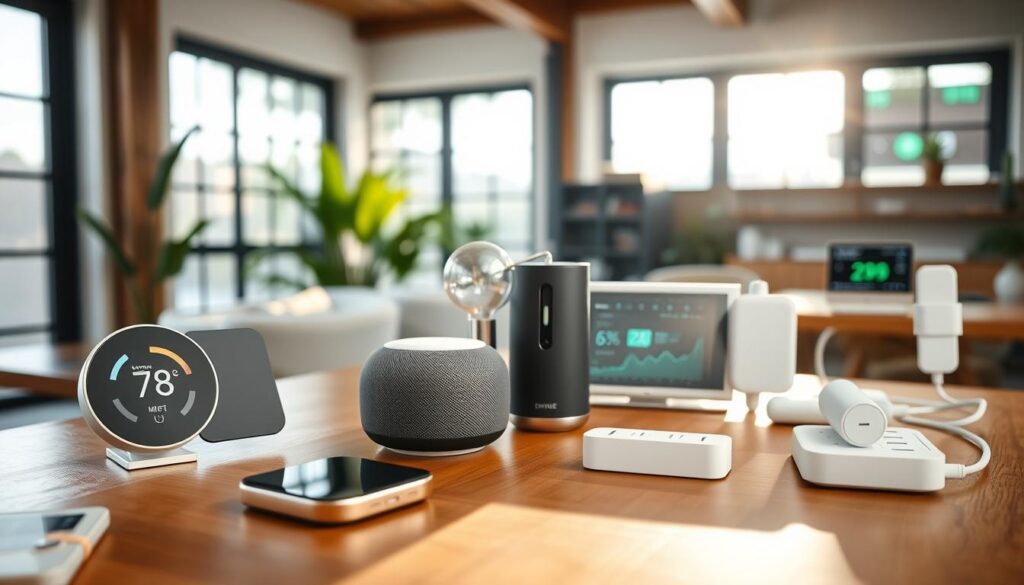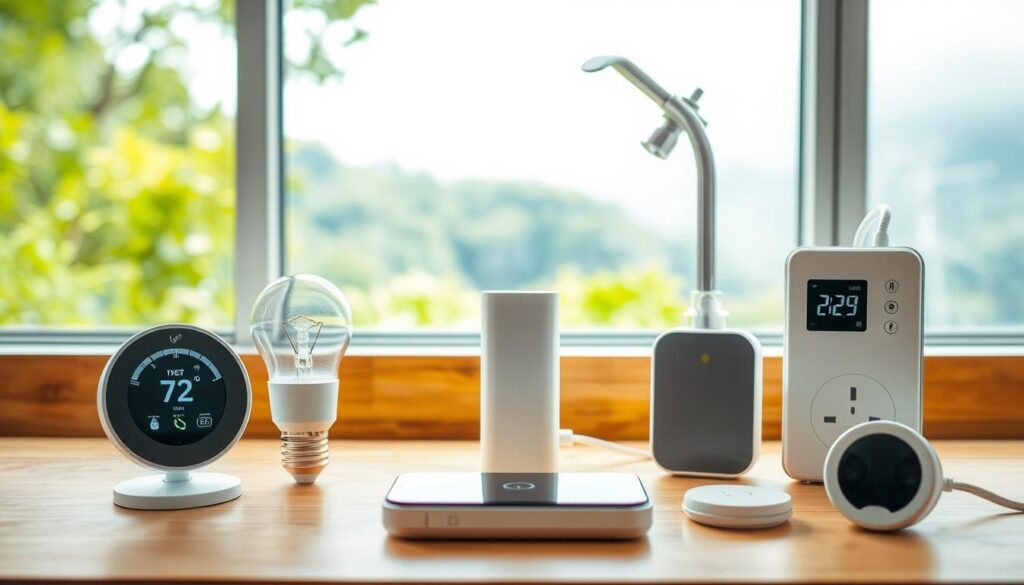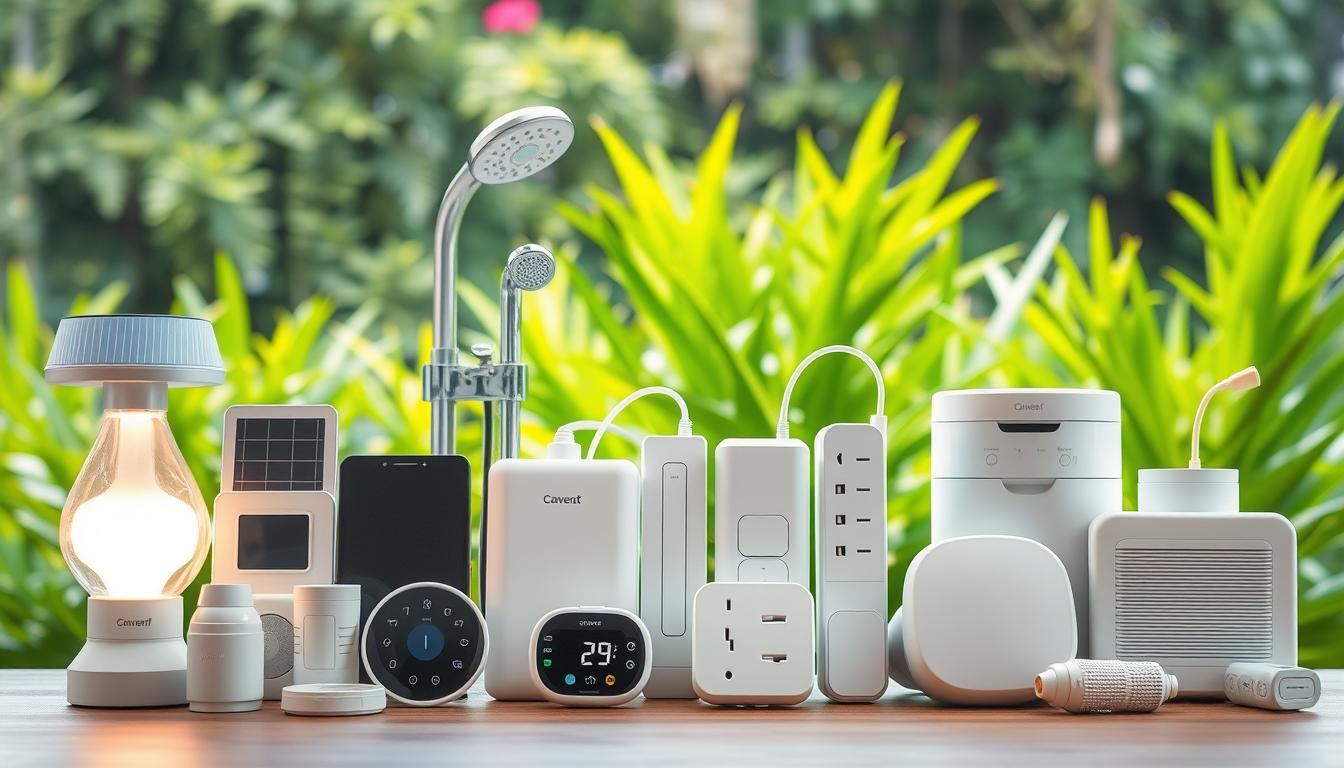Eco-friendly gadgets for home are reshaping how we live. These tools blend innovation with sustainability, helping reduce waste and energy use. Every item on this list offers practical solutions for a greener lifestyle without compromising comfort.
Discover products like solar-powered chargers, smart thermostats, and energy-efficient lighting systems. This guide highlights how eco-friendly gadgets for home save money while protecting the planet. Each section explores their benefits, history, and future potential.
Key Takeaways
- Eco-friendly gadgets for home cut energy costs and environmental impact.
- They include smart devices and renewable energy solutions.
- These tools improve daily life while supporting long-term sustainability.
- The article covers their role in modern homes and global eco-goals.
- Learn about their history, benefits, and what’s next in green tech.
Introduction: Overview of Eco-Friendly Gadgets for Home
Today’s homes are becoming hubs of sustainability, thanks to sustainable home gadgets designed to reduce waste and energy use. These innovative tools help families cut carbon footprints while saving money. From smart sensors that monitor energy use to water-saving showerheads, every device plays a role in creating a greener lifestyle.
Popular choices include Philips’ LED lighting, which uses 90% less energy than traditional bulbs, and Ecobee’s smart thermostats that learn routines to slash heating costs. Even small appliances like SodaStream carbonators reduce plastic bottle waste, proving sustainability doesn’t require overhauling your home. These gadgets work quietly in the background, making eco-conscious living effortless.
- Smart plugs that turn off devices on standby
- Compost bins with odor control, like NatureMill’s models
- Solar-powered phone chargers from Anker
Adopting these tools isn’t just about trends—it’s a step toward long-term environmental responsibility. As technology advances, so does the range of options, making it easier than ever to integrate sustainability into daily life without sacrificing convenience.
The Evolution of Green Living Technology
Green living devices have transformed homes over decades, driven by both necessity and innovation. Let’s explore how environmentally friendly home tech evolved from early experiments to today’s smart solutions.
Historical Milestones in Eco Tech
In the 1970s, the energy crisis sparked solar panel adoption. By the 1990s, the LEED certification emerged, pushing builders toward eco-conscious designs. The 2000s brought smart thermostats like Nest, blending tech with energy savings.
Technological Innovations Driving Change
Modern advancements now focus on seamless integration and efficiency. Key innovations include:
- Smart sensors that adjust lighting and heating in real time.
- AI-powered environmentally friendly home tech predicting energy use.
- Biodegradable materials in appliances, reducing waste.
| Aspect | Past Tech | Modern Tech |
|---|---|---|
| Energy Source | Fossil fuels | Solar/wind hybrids |
| Connectivity | No network integration | IoT-enabled systems |
| Material Use | Plastic-dominated designs | Recycled metals and bamboo composites |
These shifts show a clear path toward smarter, greener homes. As tech evolves, so does our ability to protect the planet without sacrificing convenience.
Benefits of Eco-friendly gadgets for home
Switching to energy-efficient home products and eco-conscious household appliances brings more than just environmental perks. These gadgets transform everyday life by saving money and reducing waste without sacrificing comfort.
Cost Savings Over Time
Smart choices like LED bulbs or solar-powered chargers cut electricity bills fast. For example, replacing five regular bulbs with LEDs can slash lighting costs by up to 80% yearly. Many eco-conscious household appliances, such as ENERGY STAR-certified refrigerators, use 40% less energy than older models. Over time, these savings add up, paying back the initial investment in just a few years.
Improved Energy Efficiency
Modern eco-gadgets optimize power use. A programmable thermostat learns your routine, adjusting heating/cooling only when needed. Here’s how efficiency stacks up:
| Appliance | Traditional Use | Eco Version |
|---|---|---|
| Washer | 500 kWh/year | 250 kWh/year |
| AC Unit | 1,200 kWh/month | 650 kWh/month |
These numbers mean less strain on grids and fewer greenhouse gases. Plus, many utilities offer rebates for upgrading, making the transition even easier.
Energy-Efficient Home Products for Sustainable Living
Transform your home into an eco-conscious hub with eco-friendly smart home devices designed to cut energy waste. These gadgets blend innovation with sustainability, making it easier than ever to reduce your carbon footprint without sacrificing comfort.

Leading brands like Nest and Philips Hue offer smart thermostats and lighting systems that learn your habits to optimize energy use. For example:
- Smart plugs track real-time energy consumption.
- Solar-powered sensors adjust lighting automatically.
- AI-driven HVAC systems slash heating/cooling costs by 30%.
| Device | Brand | Key Feature | Energy Saved |
|---|---|---|---|
| Smart Thermostat | Nest | Adapts to routines | 10-12% annual savings |
| LED Bulbs | Philips Hue | Wireless dimming | 80% less energy vs. incandescent |
| Water Sensors | Ecobee | Leak detection | Reduces water waste by 25% |
“Smart technology isn’t just convenient—it’s a game-changer for environmental stewardship.” —GreenTech Innovations Report 2023
Pair these tools with solar-powered chargers and motion-activated outlets to create a fully integrated system. Start small: upgrading one device can inspire bigger changes toward a greener lifestyle. Every smart choice adds up to a brighter, sustainable future.
Smart Integration of Sustainable Home Gadgets
Making green home technology work together with existing systems turns sustainability into a seamless experience. Modern devices now blend effortlessly into smart home ecosystems, enhancing convenience without sacrificing eco-friendly goals.
Compatibility with Home Systems
Leading brands like Nest and Philips Hue ensure their products sync with platforms like Google Home or Amazon Alexa. This compatibility simplifies control through voice commands or a single app.
- Wi-Fi enabled gadgets connect to home networks for remote monitoring
- Automated systems like the Nest Learning Thermostat adjust energy use based on daily routines
- Compatibility with energy management apps like Samsung SmartThings optimizes resource use
User-Friendly Designs
Today’s eco-devices prioritize simplicity. Touchscreens and mobile apps make adjusting settings intuitive, while voice controls eliminate the learning curve. For instance, LG’s solar-powered lights feature one-touch scheduling via their app.
- LED displays show real-time energy savings
- Modular designs allow gradual system expansion
- Auto-calibration features reduce manual adjustments
These innovations prove sustainability doesn’t mean complexity. By prioritizing accessibility, green home technology becomes a natural part of daily life.
How Green Living Devices Promote Environmental Awareness
Everyday sustainable living gadgets do more than save energy—they turn homes into classrooms. Devices like smart thermostats and solar panel monitors track usage in real time, helping users see their environmental impact firsthand.

“These tools don’t just function—they inspire action,” says Dr. Lena Carter, sustainability researcher at GreenTech Institute. “They translate abstract concepts like carbon footprints into tangible data points.”
Three ways sustainable living gadgets spark awareness:
- Smart energy monitors show peak usage patterns, encouraging efficiency.
- Water-saving showerheads display gallons conserved, linking habits to broader water scarcity issues.
- Compost bin sensors teach about waste reduction through real-time feedback.
| Gadget | Key Insight | Impact |
|---|---|---|
| Smart Thermostats (e.g., Ecobee) | Heating/Cooling Costs | 30% energy savings reported by users |
| Solar Panel Trackers (e.g., SunPower) | Renewable Energy Production | Users reduce grid reliance by 45% |
| Waste Monitors (e.g., Winnow Solutions) | Food Waste Analytics | 50% reduction in household food waste |
These tools transform households into active participants in sustainability. By making data accessible, sustainable living gadgets create a feedback loop where awareness drives behavior change, and measurable results fuel further eco-conscious decisions.
Innovative Eco-Conscious Household Appliances
Modern kitchens and living spaces now feature appliances that merge style with sustainability. Brands like LG and Samsung lead the way with devices that prioritize both performance and the planet. From refrigerators to washing machines, these innovations redefine everyday living.
Cutting-Edge Features
- AI-driven energy management systems adjust power use based on usage patterns.
- LG’s ThinQ appliances sync with smart homes to optimize efficiency, reducing waste by 30%.
- Solar-ready models like the SunPower Home System integrate with panels for off-grid energy.
Sustainable Materials and Build
Materials like recycled stainless steel and bamboo composites cut down on plastic waste. Philips’ AirPurifier uses 90% post-consumer plastic, proving style and sustainability coexist.
“Eco-design isn’t a trend—it’s our foundation.” — Siemens Home Appliances Sustainability Report 2023
Appliances like the Dyson Cyclone V10 use recyclable aluminum frames, extending product lifespans. Prioritizing durability over disposability, these innovations ensure homes operate cleaner and greener without sacrificing convenience.
Exploring the World of Eco-Friendly Smart Home Devices
Modern smart home technology is making sustainability simpler than ever. Eco-friendly smart home devices combine convenience with environmental care, helping households reduce waste and energy use. From thermostats to lighting systems, these gadgets learn your habits and adapt automatically.
- Nest Learning Thermostat: Cuts heating/cooling costs by 10-15% by adjusting temperatures when no one’s home.
- Ecobee Smart Switch: Monitors energy use of appliances, turning off idle devices to save electricity.
- Philips Hue Lightstrip: Uses LED bulbs with motion sensors, reducing unnecessary lighting.
Many devices connect via apps, showing real-time energy data. For instance, SunPower’s solar panels pair with smart inverters to optimize power storage. These tools turn sustainability into an effortless part of daily life.
| Device Type | Brand | Key Feature | Eco-Benefit |
|---|---|---|---|
| Thermostat | Nest | Auto-scheduling | Reduces heating waste |
| Lighting | Philips Hue | Motion sensors | Cuts unnecessary use |
| Appliance Control | Ecobee | Energy monitoring | Lower utility bills |
These devices often work with voice assistants like Alexa or Google Home, making setup simple. By choosing certified products like ENERGY STAR®-rated smart plugs, users ensure they’re investing in proven technology. The result? A home that’s both tech-savvy and planet-friendly.
Future Trends in Green Home Technology
From smarter energy grids to self-sustaining appliances, the next wave of eco-tech promises even bigger leaps. Here’s what’s on the horizon.
Emerging Innovations
Imagine windows that generate solar power or refrigerators that adjust energy use based on real-time weather data. These aren’t sci-fi ideas—they’re prototypes in development. Smart sensors integrated into everyday devices will soon monitor and optimize resource use automatically. Companies like Sonnen are already testing AI-driven systems that learn household habits to cut waste further. Meanwhile, biodegradable electronics made from plant-based materials could reduce e-waste by 40% by 2030.
Market Predictions and Insights
Analysts predict a 23% annual growth in the smart sustainability market through 2030. A recent study by Grand View Research highlights rising demand for hydrogen fuel cells and carbon-capture tech in homes. Major brands like LG and Google Nest are investing in modular devices that last longer, slashing the need for frequent replacements.
“The future is about tech that’s invisible but impactful,” says Dr. Emily Chen, an eco-tech innovator. “Your home will soon adapt to the planet’s needs without you even noticing.”
As these trends grow, expect more partnerships between tech giants and renewable energy firms. The goal? Homes that don’t just use less energy—they give back.
Practical Tips for Incorporating Sustainable Living Gadgets
Making the switch to eco-friendly gadgets is easier than you think. Start small and build a plan that fits your lifestyle. These steps simplify adopting sustainable tech without overwhelming your routine.
“Sustainability starts with small, actionable choices.”
Installation Best Practices
- Plan smart placements: Position solar chargers near windows and smart thermostats (like Nest Learning Thermostat) away from direct heat sources.
- Check compatibility: Ensure Wi-Fi enabled devices like Philips Hue bulbs sync with existing home networks.
- Start with energy audits: Use apps like Kill A Watt to identify high-drain appliances before installing smart plugs.
Maintenance and Upgrades
- Follow brand guidelines: Refer to manuals from brands like LG or Samsung for optimal usage cycles.
- Schedule updates: Regularly update firmware on devices like Ecobee thermostats for efficiency boosts.
- Recycle old tech: Partner with retailers like Best Buy for e-waste disposal programs.
Pair upgrades with habits like turning off devices during off-hours. Small changes compound into significant eco-impact over time.
Conclusion
Eco-friendly gadgets are essential for building a sustainable home. Innovations like solar-powered devices and smart energy monitors show how technology bridges convenience and environmental care. From early solar panels to today’s AI-driven systems, these tools save resources and lower bills. Brands like Philips and Samsung lead with products that prioritize both performance and planet-friendly design.
Every upgrade, whether LED lighting or water-saving fixtures, contributes to a greener future. As trends like smart home automation grow, adopting these gadgets becomes simpler. Start small—replace one device at a time—and watch savings and impact add up. The path to sustainability is achievable through mindful choices. Explore options like Nest thermostats or LG’s energy-efficient appliances to align tech with eco-conscious goals. Together, these steps turn homes into hubs of innovation and responsibility. The future of green living starts with the gadgets you choose today.
FAQ
What are eco-friendly gadgets for the home?
Eco-friendly gadgets for the home are devices designed to reduce environmental impact while enhancing energy efficiency. They often include smart home technology, energy-efficient home products, and eco-conscious household appliances that promote sustainable living.
How can these gadgets contribute to green living?
These gadgets assist in minimizing waste, conserving energy, and utilizing sustainable materials, which collectively help create a more environmentally friendly lifestyle. Integrating green living devices can lead to significant cost savings and a reduced carbon footprint over time.
Are there specific brands known for eco-friendly smart home devices?
Yes, several brands are recognized for their commitment to sustainability, including Philips Hue for energy-efficient lighting, Nest for smart thermostats, and Ecobee for smart energy-monitoring devices. These brands emphasize innovation in eco-conscious technology.
How do energy-efficient home products save money?
Energy-efficient home products lower utility bills by consuming less energy. For instance, LED lighting, energy-efficient appliances, and smart power strips help manage consumption without sacrificing performance, resulting in long-term financial benefits.
Can eco-friendly gadgets be integrated with existing home systems?
Absolutely! Many eco-friendly gadgets are designed for compatibility with existing home automation systems. Brands often provide user-friendly interfaces and guides to ensure seamless integration, making it easy for homeowners to adopt green home technology.
How do these gadgets promote environmental awareness?
Eco-friendly gadgets often come with features that educate users about their energy consumption and environmental impact. This awareness helps individuals make informed decisions, reinforcing sustainable practices within their households and communities.
What innovative features should I look for in eco-conscious household appliances?
Look for appliances with smart functionality, energy-saving modes, and the use of sustainable materials. Innovations like touchless controls, self-monitoring features, and durability can significantly enhance both user experience and environmental responsibility.
What future trends can we expect in green home technology?
Future trends may include advanced smart sensors that optimize energy usage, further integration of renewable energy sources, and sophisticated home automation systems that enhance overall efficiency, paving the way for a more sustainable lifestyle.
How can I effectively maintain my sustainable living gadgets?
Regular maintenance is key! Follow the manufacturer’s guidelines for upkeep, perform routine checks to ensure optimal performance, and consider upgrades as technology advances. Proper care will extend the lifespan of your devices, maximizing both sustainability and savings.
